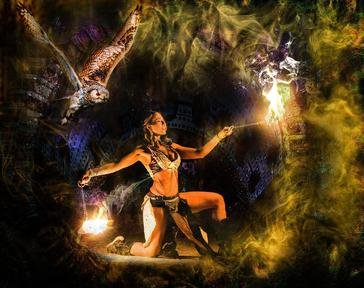Quiz Answer Key and Fun Facts
1. A teacher's pet, this prima rose by her toes through the ranks of the Mariinsky through the classics of Giselle, "The Sleeping Beauty" and "The Pharoah's Daughter", but it was her work as "The Dying Swan" that made the audiences of that time love which dancer best?
2. Considered "the father of American ballet", this dancer's roots are in a much different place. Dragged kicking and screaming into ballet by his artsy family, he thrived and would go on to draw from a never ending supply of muses as he set many of the ballet classics, from "The Nutcracker" to "Don Quixote". Which ballet master brought modern ballet to America?
3. The creator of modern dance, this dancer taught herself her own unique artform from her San Francisco home from the time she was six. Eventually, oppressed by the limitations of dance, she went abroad, finding fame in Europe. Her body movements were natural, often influenced Ancient Greece, as were details like the tunic she performed in during those times, but what was her name?
4. The next dancer on tap gained recognition for his work dancing in a series of 1930s movies and musicals. His dance career started young, hoofing for a living in Virginia, which eventually led to work in vaudeville. His dance career literally climbed the stairs, when Hollywood came calling which dancer in 1935 for his part in "The Littlest Colonel"?
5. From her Native American roots to the world stage, this next dancer has the honor of being the first prima ballerina produced by the United States. At a towering (for a ballerina) height of 5'9", which ballerina's style and passion pointed her toward greatness and a place in ballet history?
6. Initially paired with his sister, Adele, the duo's earliest stage show involved this dancer wearing a lobster suit. The duo soon outgrew one another as Adele married and her brother moved on to dancing the "Gay Divorcee" on Broadway. The show's success launched a movie version and an eventual career in Hollywood for which dancer partnering in the age of dance on film?
7. Widely considered the most perfect dancer the critics had ever seen, this next dancer chassed from his humble beginnings in Latvia to expanding his artistic influence after defecting from Soviet rule during the Kirov's tour of Canada. Which dancer is known for the purity of his ballet technique and virtuosity of his jumps and turns on stage and screen?
8. Known for his stylistic mixture of ballet and modern dance, this next dancer was raised by a single mom in racially segregated Texas. In his early life, marked by abandonment and violence, he found solace in the arts after moving to California. Whose talent eventually carried him to New York where he had revelations, founding a famed African American modern dance company?
9. With ballet prowess extending to an ability to dance en pointe, this next dancer took on the family business of dance. Trained at the Imperial Ballet School in St Petersburg, he was an instant success upon joining the company as a coryphee (instead of a corp de ballet member). Joining the Ballet Russe, which dancer became internationally infamous for his risqué choreography and ballet virtuosity?
10. A ballerina whose virtuosity led her to both prima ballerina status and a Dame of the Order of the British Empire, this dancer's early roots came from Russian tutelage studying abroad in China. She returned to England to complete her training, joining the Sadler Wells ballet company. Which grande dame is considered one of the greatest classical ballerinas of all time?
Source: Author
TemptressToo
This quiz was reviewed by FunTrivia editor
bloomsby before going online.
Any errors found in FunTrivia content are routinely corrected through our feedback system.

